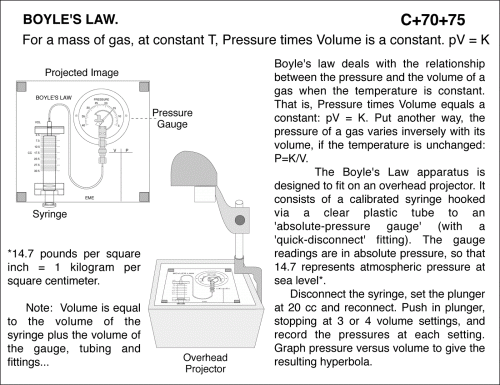Boyle's Law: At constant T, Pressure times Volume is a constant.
Primary tabs
For a mass of gas, at constant T, Pressure times Volume is a constant. pV = K. Boyle's law deals with the relationship between the pressure and the volume of a gas when the temperature is constant. That is, Pressure times Volume equals a constant: pV = K. Put another way, the pressure of a gas varies inversely with its volume, if the temperature is unchanged: P=K/V. The Boyle's Law apparatus is designed to fit on an overhead projector. It consists of a calibrated syringe hooked via a clear plastic tube to an 'absolute-pressure gauge' (with a 'quick-disconnect' fitting). The gauge readings are in absolute pressure, so that 14.7 represents atmospheric pressure at sea level*. Disconnect the syringe, set the plunger at 20 cc and reconnect. Push in plunger, stopping at 3 or 4 volume settings, and record the pressures at each setting. Graph pressure versus volume to give the resulting hyperbola. *14.7 pounds per square inch = 1 kilogram per square centimeter. Note: Volume is equal to the volume of the syringe plus the volume of the gauge, tubing and fittings
UCB Index:
C+70+75
PIRA Index:
4E20.10
UCB Taxonomy:
PIRA Taxonomy:
Video:
Popularity:
Previous:
- Log in to post comments

